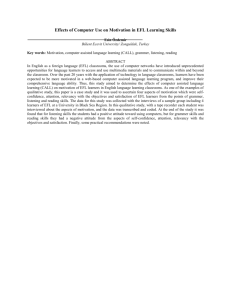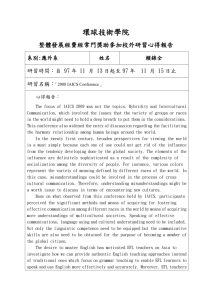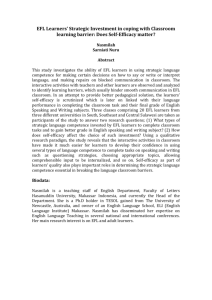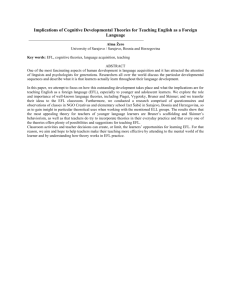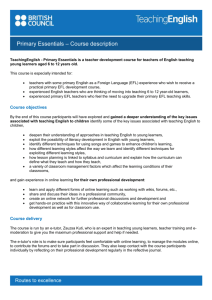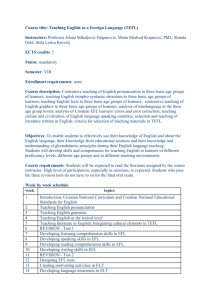Fulltext - International Journal of Basic Sciences and Applied
advertisement
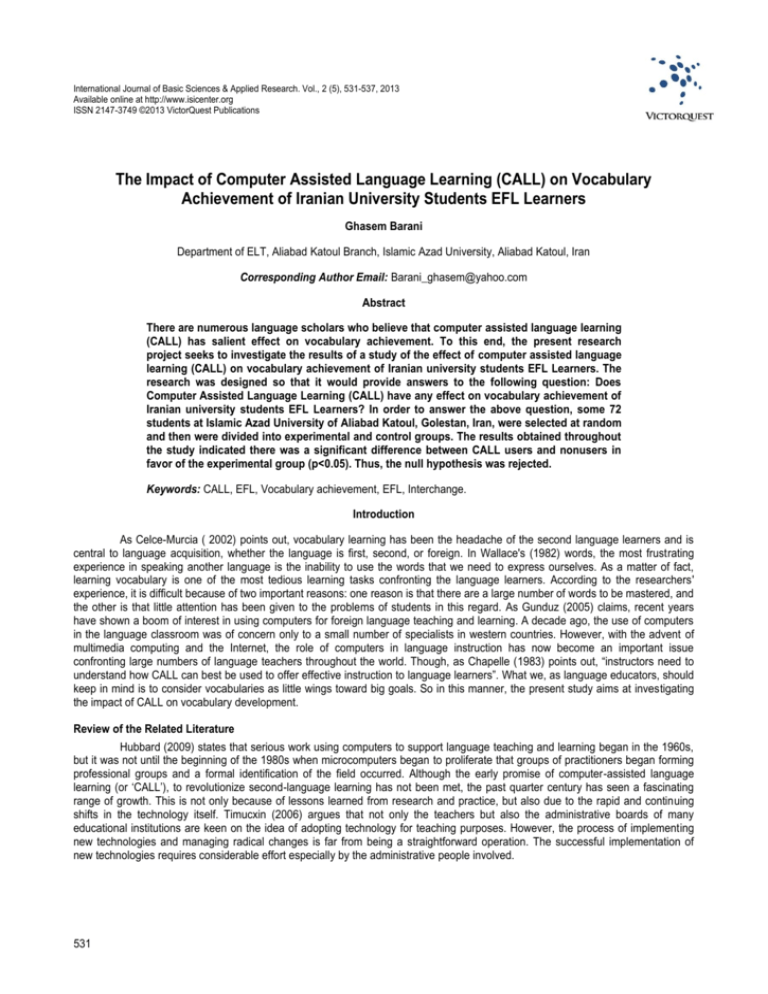
Intl. j. Basic. Sci. Appl. Res. Vol., 2 (5), 531-537, 2013 International Journal of Basic Sciences & Applied Research. Vol., 2 (5), 531-537, 2013 Available online at http://www.isicenter.org ISSN 2147-3749 ©2013 VictorQuest Publications The Impact of Computer Assisted Language Learning (CALL) on Vocabulary Achievement of Iranian University Students EFL Learners Ghasem Barani Department of ELT, Aliabad Katoul Branch, Islamic Azad University, Aliabad Katoul, Iran Corresponding Author Email: Barani_ghasem@yahoo.com Abstract There are numerous language scholars who believe that computer assisted language learning (CALL) has salient effect on vocabulary achievement. To this end, the present research project seeks to investigate the results of a study of the effect of computer assisted language learning (CALL) on vocabulary achievement of Iranian university students EFL Learners. The research was designed so that it would provide answers to the following question: Does Computer Assisted Language Learning (CALL) have any effect on vocabulary achievement of Iranian university students EFL Learners? In order to answer the above question, some 72 students at Islamic Azad University of Aliabad Katoul, Golestan, Iran, were selected at random and then were divided into experimental and control groups. The results obtained throughout the study indicated there was a significant difference between CALL users and nonusers in favor of the experimental group (p<0.05). Thus, the null hypothesis was rejected. Keywords: CALL, EFL, Vocabulary achievement, EFL, Interchange. Introduction As Celce-Murcia ( 2002) points out, vocabulary learning has been the headache of the second language learners and is central to language acquisition, whether the language is first, second, or foreign. In Wallace's (1982) words, the most frustrating experience in speaking another language is the inability to use the words that we need to express ourselves. As a matter of fact, learning vocabulary is one of the most tedious learning tasks confronting the language learners. According to the researchers' experience, it is difficult because of two important reasons: one reason is that there are a large number of words to be mastered, and the other is that little attention has been given to the problems of students in this regard. As Gunduz (2005) claims, recent years have shown a boom of interest in using computers for foreign language teaching and learning. A decade ago, the use of computers in the language classroom was of concern only to a small number of specialists in western countries. However, with the advent of multimedia computing and the Internet, the role of computers in language instruction has now become an important issue confronting large numbers of language teachers throughout the world. Though, as Chapelle (1983) points out, “instructors need to understand how CALL can best be used to offer effective instruction to language learners”. What we, as language educators, should keep in mind is to consider vocabularies as little wings toward big goals. So in this manner, the present study aims at investigating the impact of CALL on vocabulary development. Review of the Related Literature Hubbard (2009) states that serious work using computers to support language teaching and learning began in the 1960s, but it was not until the beginning of the 1980s when microcomputers began to proliferate that groups of practitioners began forming professional groups and a formal identification of the field occurred. Although the early promise of computer-assisted language learning (or „CALL‟), to revolutionize second-language learning has not been met, the past quarter century has seen a fascinating range of growth. This is not only because of lessons learned from research and practice, but also due to the rapid and continuing shifts in the technology itself. Timucxin (2006) argues that not only the teachers but also the administrative boards of many educational institutions are keen on the idea of adopting technology for teaching purposes. However, the process of implementing new technologies and managing radical changes is far from being a straightforward operation. The successful implementation of new technologies requires considerable effort especially by the administrative people involved. 135 Intl. j. Basic. Sci. Appl. Res. Vol., 2 (5), 531-537, 2013 Theoretical basis for CALL instruction design Computers have become so widespread in schools and homes and their uses have expanded so dramatically that the majority of language teachers now think about the implications. Technology brings about changes in the teaching methodologies of foreign language unless they are used simply to automate fill-in-the-gap exercises. The use of the computer in and of itself does not constitute a teaching method, but rather the computer forces pedagogy to think in new ways to exploit the computers benefits and work around its limitations. To exploit computers‟ potential we need language teaching specialists who can promote a complementary relationship between computer technology and appropriate pedagogic programs (King, 2003). Schwienhorst (2002) asserts that a number of pedagogical approaches have developed in the computer age, including the communicative and integrative/experimentative approaches outlined above in the History of CALL. Others include constructivism, whole language theory and sociocultural theory although they are not exclusively theories of language learning. With constructivism, students are active participants in a task in which they “construct” new knowledge based on experience in order to incorporate new ideas into their already-established schema of knowledge. Whole language theory postulates that language learning (either native or second language) moves from the whole to the part; rather than building sub-skills like grammar to lead toward higher abilities like reading comprehension, whole language insists the opposite is the way we really learn to use language. Students learn grammar and other sub-skills by making intelligent guesses bases on the input they have experienced. It also promotes that the four skills (reading, writing, listening and speaking) are interrelated. Sociocultural theory states that learning is a process of becoming part of a desired community and learning that communities rules of behavior (Roblyer, 2003). What most of these approaches have in common is taking the central focus away from the teacher as conveyor of knowledge to giving students learning experiences that are as realistic as possible where they play a central role. Also, these approaches tend to emphasize fluency over accuracy to allow students to take risks in using more student-centered activities and to cooperate, rather than compete. The computer provides opportunity for students to be less dependent on a teacher and have more freedom to experiment on their own with natural language in natural or semi-natural settings. The History of CALL Although computers have been used since the first half of the 20th century, they were not used for educational purposes until the 1960s. The 1970s witnessed the evolution of CALL as a result of development in research related to the use of computers for linguistic purposes and for creating suitable language learning conditions. In America the computer based introductory courses in the 1960s were pioneering projects in CALL, and were referred to as Computer Assisted Instruction (CAI) The 1980s have witnessed the spread of computers both in educational institutions and in people's homes. Since the beginning of the '80s computers have also found their way into many schools. CALL software has also become more readily available on the market (Ittelson, 2000). The emergence of inexpensive computer technology and mass storage media, including optical videodiscs and compact disks, has given instructional technologists better tools to work with. Compact disks are used to store large amounts of data, such as encyclopedias or motion pictures. In CALL centers with computers and software such as CD-ROM, CD-I, or videodiscs, a student who is interested in a particular topic can first scan an electronic encyclopedia, then view a film on the subject or look at related topics at the reach of a button. Thus, such learning centers present students with the advantages of reference materials and popularize computer-aided instruction. The computer laboratory has become an integral component of foreign-language programs in most educational institutions (Holmes, 1989). Computers have been used for language teaching for more than three decades. According to Holmes (1989) the history of CALL can be divided into three stages: behavioristic CALL, communicative CALL and integrative CALL. Each stage corresponds to a certain pedagogical approach. Behavioristic CALL It was formed in the late 1960s and used widely in the 1970s under the influence of Audio-lingual teaching method. In this stage of CALL, repetitive language drills, referred to as drill-and practice were used. The computer was seen as a mechanical tutor who never allowed students to work at an individual pace, which hindered motivation. Further, it included extensive drills, grammatical explanations and translation at various intervals (Warschauer & Healey 1998). Communicative CALL It was the period of the 1980s. This period was the time that behaviouristic approach to language teaching was being rejected at both theoretical and pedagogical level, and also personal computers were creating greater possibilities for individual work at school. Communicative CALL corresponded to cognitive theories which stressed that learning was a process of discovery, expression and development. Under the influence of Communicative Language Teaching defendants of communicative CALL argued that computer based activities should focus more on using forms. Software developed in this period included text reconstruction program and simulations. In communicative CALL, the focus was not so much on what students did with the computer, but rather what they did with each other while working at the computer. Interactive CALL By the 1990s communicative CALL began to be criticized. New second language acquisition theories and socio-cognitive views influenced many teachers and lead them to use more social and learner-centered methods. This time, emphasis was put on language use in authentic social contexts. Task-based, project-based and content-based approaches all sought to integrate learners 135 Intl. j. Basic. Sci. Appl. Res. Vol., 2 (5), 531-537, 2013 in authentic environments, and also to integrate the various skills of language learning and use. In integrative approaches, students are enabled to use a variety of technological tools as an on going process of language learning and use rather than visiting the computer lab once a week basis for isolated exercises. Language needs analysis We need to take into account what learner ultimately wants to do through the language, and to think the course objectives to the kind of language interaction which the learner‟s purpose is likely to entail. Since the 1970s, the clarification of aims and objectives have been a major preoccupation of linguistics and language specialists. Among these, Stern (1983), cross-tabulates four wide categories of objective: proficiency, knowledge, affect, and transfer, with four equally broad content categories: language, culture, communication, and general language education. He states that „the table merely provides a map‟ and that „the actual circumstances of teaching require the interpretation of these categories in order to decide which objectives and content categories to give priority to‟(Stern, 5983). Wilkins (5976) recommends adapting a semantic approach which focuses on the types of meaning learners will want to express and proposed a framework for categorizing what speakers communicative through language. He thinks that defining objectives is the first step in the construction of any language syllabus or course. For example, the Threshold Level Project, which seeks to define language learning objectives as exactly as possibly in terms of what the learner will need to do with the language. The Internet By the mid-1990's, experts estimated that more than fifty million computers were linked to the information superhighway by way of a network called the Internet (Net). The internet is a computer-based worldwide information network. It is composed of a large number of smaller interconnected networks called internets. These internets may connect tens, hundreds or thousands of computers, enabling them to share information through a series of fibrotic cables (Mahmoudi, 2012; Rahimi, 2011). With a 'Personal Computer' (PC) you can get connected to the internet via a 'Modem' (Modulator- Demodulator) which is a very small device and can be attached to your computer. It connects your computer to another or other computers over communication/telephone lines. The internet is made up of a combination of various software applications, each with its own unique function. However, in order to take advantage of the greatest Internet software like the Netscape Navigator for exploring the Web you will need a late-model Macintosh or PC running Microsoft Windows or Windows. Once on the Net you will be able to get access to: • E-mail: Electronic mail which allows you to instantly send and receive messages from all over the world; • WWW: World Wide Web; • Chat: a way to communicate in real time to others; On the Internet, there are databases that contain information on every branch of human knowledge and enterprise- from the most serious scientific topics to catalogues of jokes. Due to advances in the worldwide telecommunication systems, the Internet has become a global network and universities, businesses, and individual users in virtually every nation are on the Net. The Internet and ELT English teachers are in a constant need of additional teaching materials; therefore, the internet is an invaluable recourse for them. Since the most common objective for language learners is better communication, the internet will improve their communication skills. For the teacher aiming to provide the desirable dynamic learning environment, the need for appropriate and stimulating resources and experiences are never greater, and it is here that the Internet can make a significant and unique contribution. A teacher can get access to english teaching support of many kinds through the WWW sites specialized in english teaching; download a wealth of realia from newspapers, tourism and hobby-based WWW sites to use in class. The internet also widens the students' horizons, provides regular confirmation of the usefulness of proficiency in the language and gives powerful stimulus to the broader education process. Although the internet is a terrific resource for accessing full-text newspapers, magazines, journals, reference works and even books, there is the problem of where to begin, which might be overwhelming for novice users; for, there is an infinite amount of information and recourses. However, there are tools such as Search Engines, Directories, Libraries and Online Encyclopedias that can help find the information you are looking for, whether it is a particular EFL software or information on CALL (Mahmoudi, 2012; Rahimi, 2011). The rise of computer-mediated communication and the Internet has reshaped the uses computers for language learning at the end of the 20th century. With arrival of the Internet, the computer-both in society and in the classroom-has been transformed from a tool for information processing and display to a tool for information processing and communication (Sperling, 1998). For the first time, learners of a language can now communicate inexpensively and quickly with other learners or speakers of the target language all over the world. This communication can be either synchronous (with all users logged on and chatting at the same time) or asynchronous (with a delayed message system such as electronic mail) (Warschauer, 1998). With the World Wide Web, learners of many languages have access to an unprecedented amount of authentic target-language information, as well as possibilities to publish and distribute their own multimedia information for an international audience. Dudeney (cited in Sperling, 1998) enthusiastically reports that the internet is like a library which is five minutes old. Similarly, Gray (cited in Sperling, 1998) states that 133 Intl. j. Basic. Sci. Appl. Res. Vol., 2 (5), 531-537, 2013 the internet is such an amazing seemingly infinite collection of recourses that with access to all this information teachers can be more creative and up-to-date. In sum, the internet enables students of English to: • Correspond in english by e-mail with other classes in other parts of the world; • Develop individual-pen-pals to write to them; • Communicate in real-time chat rooms; • Share opinions and ideas across cultures on sports, music, food, hobbies, etc.; • Conduct international surveys for class work; • Read and listen to up to date news; Multimedia CALL concerns software programs designed specifically for teaching and learning languages. A major impact has been created by the arrival of CD-ROMs (Compact Disk read only memory) another invaluable material for teachers and learners; multimedia and an integration of text, audio and video material all in one package is seen now, whereas everything was 'text-based CALL' in the past (Jarvis, 2000). Multimedia computing, the Internet, and the World Wide Web provide an incredible boost to Computer Assisted Language Learning (CALL) applications. First ignored, CALL is finally achieving the recognition it deserves thanks in large part to these developing technologies (Mahmoudi, 2012; Rahimi, 2011). Personal computers enable users to interact with multimedia programs- that is, users become active participants rather than passive observers. Many computer programs combine several types of media, such as text, graphics, animation, and sound. However, most programs do not offer television and film clips or digital stereo sound. Such high-quality video and audio distinguish multimedia from other programs. Desktop computers are now able to play natural human speech together with full screen interactive video which was impossible just a few years ago. Users can now communicate and interact with one another in real-time (Mahmoudi, 2012; Rahimi, 2011). The advantage of CD-ROM is that it can offer books, videos, audio-cassettes, language labs and computer language games as individual methods of study all together, in such a small package. However, it takes time for sound and pictures to appear on the screen, so the more video or audio it has, the longer everything is going to take. In today's world people are too impatient and not willing to wait any longer than two seconds before they expect something to happen. The fun and the learning potential of the CD-ROM is that it enables individuals (or at most two or three students on one computer) control their own learning. Before buying and using CD-ROMs, it is worth understanding what you can expect and what you want and evaluate this form of material. Therefore, a language teacher should consider the following: • How do you want to use it? • What and how is it teaching? • How easy is it to use? • What back-up is there? • What methodological features does it use? • What makes it different to learning from a book? If after all these considerations, the package appears to meet your demands and the price fits your budget then buying it would be worthwhile for language learning (Schwienhorst ,2002). Methodology This study tried to determine if Computer Assisted Language Learning (CALL) has any effect on vocabulary learning of Iranian university students. The null hypothesis in this research asserted that there is no relationship between Computer Assisted Language Learning (CALL) and vocabulary achievement of Iranian EFL learners. In trying to accept or reject the null hypothesis, the researcher employed different t-tests. Subjects In order to conduct the research project, the researcher selected some 40 university students, aged 18-42, out of 72 students from among three similar classes in Islamic Azad University of Aliabad Katoul, Iran. Their mother tongue was Persian and 135 Intl. j. Basic. Sci. Appl. Res. Vol., 2 (5), 531-537, 2013 all of them were intermediate EFL learners. The subjects were divided into two similar classes of 20, one of which was considered as the experimental group and the other as the control group. Materials Interchange Book 1, (Richards, 2005) was the focus of the present study. The syllabus covered in this study is the same syllabus used by other instructors at different universities and language institutes. This material was available into two forms: (a) hard copy for the control group, and (b) CALL for the experimental group. Instrumentation To make sure that the present study enjoys the needed appropriateness, the researcher applied three instruments: Nelson Test In order to check the homogeneity of the groups, a valid test of Nelson was given to the students in the very first session. The total score was 100 points distributed among multiple choice items. A Proficiency Test This test, a vocabulary test, is a word bank consisting of all new vocabulary items in Interchange 1, (Richards, 2005), was given to the subjects in the first session of the semester. The subjects were required to translate the given words into Persian. The goal here was to make sure what words already were unknown to both groups. An Achievement Test This test, a vocabulary test, was administered both to the experimental group and the control group in the last session of the semester. The subjects were asked to translate the given words into Persian. Procedure To accomplish the purpose of the study, researcher carried out the following procedure: in this study, the subjects were 73 both male and female learners from among three similar classes. In this research, three data gathering devices were employed: Nelson Test, a vocabulary test, and an achievement test. Under testing conditions, the subjects were asked to take the Nelson Test. Then, researchers limited the subjects to 40 on the basis of their scores. The researcher selected the subjects whose scores were one standard deviation below and above the mean. The subjects were divided into two homogeneous groups, considering one as the control group and the other as the experimental group. Each group included 20 homogenous learners. Then, a vocabulary test (as a pretest) which was a word bank consisting of all new words in Interchange Book1, (Richards, 2005), was administered to the subjects in both groups. Both groups were to translate all of those words into Persian. The goal here was to make sure what words were unknown to the subjects in both groups. After the administration of the vocabulary test, about 64 words out of 226 new words were excluded from the program since these words were already known to the subjects in both groups. During the study, researchers taught each group in 10 sessions (each session 90 minutes). The control group sessions were held on odd days from 4-5:30 p.m. in class No. 101, and the experimental group sessions were held on even days from 4-5:30 p.m. at the same class. During the 10 session instruction, researchers presented and practiced all these unknown words through the curriculum book, Interchange Book 1, to the subjects in the control group and the language software to the experimental group. Results The results of the pretest and posttest which served as the statistical basis for the two groups and a t-test comparison of group means showed a t value of -10.060. The table of T-critical with 58 degree of freedom for 0.05 level shows T-critical of 1.96. The T-critical is smaller than the t observed -10.060 > 6.47. Our t value is high enough that we can safely reject the null hypothesis: "CALL has a significant effect on vocabulary learning among Iranian university students EFL learners." Table 1. Descriptive statistics of the pretest: Experimental/Control group. Pair 1 Control group Experimental group Mean 67.73 66.73 N 30 30 SD 12.60 12.51 Std. Error Mean 2.30 2.28 According to Table 1, the means obtained from the vocabulary test (as a pretest) were very close. The Experimental Group had a mean of 67.73, and the Control Group a mean of 66.73, confirming the homogeneity of the groups. Table 2. Descriptive statistics: posttest Experimental/Control group. Control group Experimental group Valid N (listwise) 131 Mean 129.1667 140.33 N 30 30 30 SD 20.7912 31.34 Variance 753.109 982.023 Intl. j. Basic. Sci. Appl. Res. Vol., 2 (5), 531-537, 2013 The results of the posttest showed that the experimental group had a mean of 140.33 and the control group a mean of 129.1667. It may therefore be claimed that the experimental group outperformed the control group on the posttest. The result of ttest between the two groups was not significant at concluding that the two groups behaved the same and were, therefore, homogenous (t=0.385, p<0.05) Table 3. Descriptive statistics: posttest control Group/Experimental group. Pair Control group 1 Experimental group Mean N SD Std. Error Mean 129.17 30 20.79 4.12 140.33 30 31.34 5.72 The main determining factor for the effectiveness of the treatment in this research was the difference between the performance of the Experimental Group and the Control Group on the vocabulary test (as a posttest). Results showed that the Experimental Group with a mean of 140.33 did outperform the Control Group with the mean of 129.17. The t-test (5.089) was significant at 0.05 level. It could be concluded that the treatment given to the Experimental Group had a positive impact on enhancing the students‟ performance on the vocabulary test. Discussion and Conclusion The research reported here casts a new light on the question of CALL effectiveness in the context of EFL learning and teaching. These results were in alignment with the principles of constructivism, which is used as part of the theoretical framework of the present study. Constructivism claimed that technology could (a) provide a context for learning that supports both autonomy and relatedness, (b) could support self-regulation through the promotion of skills and attitudes, and (c) could strengthen the learner‟s tendency to engage in intentional learning processes. In addition, this significant difference is consistent with other studies that investigated the effect of CALL on learning foreign languages. CALL has important potential for English language teaching. If used properly with clear educational objectives, CALL can interest and motivate learners of English. CALL can increase information access to the learner, provide flexibility to instruction and thereby better serve the individual's learning pace, cognitive style and learning strategies. CALL allows learners to control their own learning process and progress. Using effective and suitable software applications, CALL can provide communicative meaningful language learning environments. Good quality and well-designed CALL software can offer a balance of controlled practice and free communicative expression to the learners, including immediate feedback. In the future, with the advance of computer technologies, it is expected that CALL will be able to absorb some teaching functions. The effectiveness of CALL relies on how CALL is utilized to meet language learning goals for individualized learners in specific educational settings. The role of computers in language teaching has changed significantly in the last three decades. Previously, computers used in language teaching were limited to text. Simple simulations and exercises, primarily gap-filling and multiple-choice drills, abounded. Technological and pedagogical developments now allow us to integrate computer technology into the language learning process. Multimedia programs incorporating speech-recognition software can immerse students into rich environments for language practice. Concordance software with large language corpora provides students with the means to investigate language use in authentic contexts. And the Internet allows for a great number of opportunities to communicate in the target language, access textual and multimedia information, and publish for a global audience. It can be seen that there is a boom in the use of computers in the past thirty years from having students work on computer fed drills to students' long-distance communication and collaboration in authentic research and multimedia publication. Since the computer is capable of playing so many different roles in and out of class, it is believed to be the most exciting and potentially useful aid so far available to language teachers and learners. Theoretically, the findings of the study indicate that EFL learners can learn language better through CALL. In the contemporary world of today, significance of a new idea is only obliged to take into account both instrumentally and practically. The present study was an attempt to investigate the utility of the effect of CALL on EFL learning. To be more specific, this study can have certain implications for materials development, teaching and learning. The EFL materials developers should be aware of the impact of CALL on competencies of EFL learners. Having fully-fledged materials, the teacher's power of maneuverability will increase. As a result, the students will enjoy an optimal methodology adopted by their teacher. This study attempted to add a smidgen of support to the implementation of CALL in the domain of EFL learning. If this mission is accomplished, students can benefit more from such materials. The conclusions emerging from this study have implications for both EFL teachers and material designers. Since CALL proved to be useful in actual classroom procedure with Iranian EFL learners, EFL teachers can adopt the technique in their classes to advance their students‟ language proficiency. References Celce-Murcia M, 2002. Teaching English as a second or foreign language, 3rd edn. U.S.A.: Heinle & Heinle Publishers. Chapelle CA, Jamieson JM, 1983. Language lessons on the PLATO IV system. System. 11: 13-20. Gunduz N, 2005. Computer Assisted Language Learning. Journal of Language and Linguistics. 1(2): 193-214. 136 Intl. j. Basic. Sci. Appl. Res. Vol., 2 (5), 531-537, 2013 Holmes B, 1998. Initial perceptions of CALL by Japanese university students. Computer Assisted Language Learning. 11(4): 397409. Hubbard PH, 2009. Computer assisted language learning. USA: Taylor & Francis Group. Ittelson JC, 2000. Computers. Microsoft Encarta encyclopedia 2000. 1993-1999 Microsoft Corporation. Jarvis H, 2000. Current issues. Met. 9: 62-69. King L, 2003. Improving the quality of language learning in schools: approaches to teaching and learning, London: CILT. Mahmoudi E, Bt Abdul Samad A, Bt Abdul Razak NZ, 2012. Attitude and Students‟ Performance in Computer Assisted English Language Learning (CAELL) for Learning Vocabulary. Social and Behavioral Sciences. 6(7): 489-498. Rahimi M, Yadollahi S, 2011. Foreign language learning attitude as a predictor of attitudes towards computer assisted language. learning Computer Science. 3: 167-174. Richards JC, Hull J, Proctor S, 2005. Student's book 1, 3 rd edn. Cambridge: Cambridge University Press. Roblyer M, 2003. Integrating educational technology into teaching. Columbus, Ohio: Person Education. Schwienhorst K, 2002. Why virtual, why environments? Implementing virtual reality concepts in computer assisted language learning. Simulation & Gaming. 33(2): 196-209. Sperling D, 1998. Internet guide, 2nd edn. New Jersey: Prentice Hall Regents. Stern HH, 1983. Fundamental concepts of Language Teaching. Oxford: Oxford University Press. Timucxin M, 2006. Implementing CALL in an EFL context. ELT Journal. 60(3): 262-271. Wallace M, 1982. Teaching vocabulary. London: Heinmann. Warschauer M, Healey D, 1998. Computers and language learning: an overview. Language Teaching. 31: 57-71. Wilkins DA, 1976. National syllabuses. Oxford: Oxford University Press. 137
